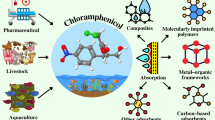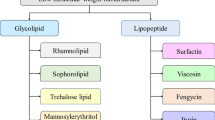Abstract
The adsorption behavior of five surfactants, cetyltrimethylammonium bromide (CTAB), Triton X-100, Tween 80, sodium dodecyl sulfate (SDS), and rhamnolipid, on a Pseudomonas aeruginosa strain and the effect of temperature and ionic strength (IS) on the adsorption were studied. The change of cell surface lypohydrophilic property caused by surfactant adsorption was also investigated. The results showed that the adsorption kinetics of the surfactants on the cell followed the second-order law. CTAB adsorption was the fastest one under the experimental conditions, and it took longest for SDS adsorption to equilibrate because of electric repulsion. The adsorption of Triton X-100 and Tween 80 was characterized by short equilibration time, and rhamnolipid adsorption reached equilibrium in about 90 min. The adsorption isotherms of all the surfactants on the bacterium fitted Freundlich equation well, but the adsorption capacity and mode were variations for the surfactants as indicated by k and n parameters in the equations. The adsorption mode for all the surfactants except SDS is probably hydrophilic interaction because the adsorption totally turned the cell surface to be more hydrophobic. Neither the temperature nor the IS had significant effect on CTAB adsorption, but higher IS significantly enhanced SDS adsorption and modestly strengthened adsorption of Triton X-100, Tween 80, and rhamnolipid. Higher temperature strengthened adsorption of SDS but weakened the adsorption of Triton X-100, Tween 80, and rhamnolipid.





Similar content being viewed by others
References
Ahimou F, Denis FA, Touhami A, Dufrêne YF (2002) Probing microbial cell surface charges by atomic force microscopy. Langmuir 18:9937–9941
Bai GY, Brusseau ML, Miller RM (1997) Influence of a rhamnolipid biosurfactant on the transport of bacteria through a sandy soil. Appl Environ Microbiol 63:1866–1873
Brown DG, Jaffé PR (2006) Effects of nonionic surfactants on the cell surface hydrophobicity and apparent Hamaker constant of a Sphingomonas sp. Environ Sci Technol 40:195–201
Brownawell BJ, Chen H, Zhang WJ, Westall JC (1997) Adsorption of non-ionic surfactants on sediment materials. Environ Sci Technol 31:1735–1741
Dubey KV, Juwarkar AA (2005) Adsorption–desorption process using wood-based activated carbon for recovery of biosurfactant from fermented distillery wastewater. Biotechnol Prog 21:860–867
Gallego JLR, Loredo J, Llamas JF, Vázquez F, Sánchez J (2001) Bioremediation of diesel-contaminated soils: evaluation of potential in situ techniques by study of bacterial degradation. Biodegradation 12:325–335
Gürses A, Yalçin M, Sözbilir M, Doğar Ç (2003) The investigation of adsorption thermodynamics and mechanism of a cationic surfactant, CTAB, onto powdered active carbon. Fuel Process Technol 81:57–66
Hillgren A, Evertsson H, Aldén1 M (2002) Interaction between lactate dehydrogenase and Tween 80 in aqueous solution. Pharm Res 19:504–510
Hu CG, Dang XP, Hu SS (2004) Studies on adsorption of cetyltrimethylammonium bromide at carbon paste electrode and the enhancement effect in thyroxine reduction by voltammetry and electrochemical impedance spectroscopy. J Electroanal Chem 572:161–171
Ishigami Y, Gama Y, Nagahora H, Yamagughi M, Nakahara H, Kamata T (1987) The pH-sensitive conversion of molecular aggregates of rhamnolipid biosurfactant. Chem Lett 763–767
Jiang JQ, Cooper C, Ouki S (2002) Comparison of modified montmorillonite adsorbents. Part I: preparation, characterization and phenol adsorption. Chemosphere 47:711–716
Karahan S, Yurdakoç M, Seki Y, Yurdakoç K (2006) Removal of boron from aqueous solution by clays and modified clays. J Colloid Interface Sci 293:36–42
Li Q, Logan BE (1999) Enhancing bacteria transport for bioaugmentation of aquifers using low ion strength solutions and surfactants. Water Res 33:1090–1100
Liu TQ, Guo R, Song GP (1999) Determination of the micellar properties of Triton X-100 by voltammetry method. J Dispers Sci Technol 20:1205–1221
Mata-Sandoval JC, Karns J, Torrents A (1999) High performance liquid chromatography method for the characterization of rhamnolipid mixtures produced by P. aeruginosa UG2 on corn oil. J Chromatogr A 864:211–220
Mata-Sandoval JC, Karns J, Torrents A (2001) Influence of rhamnolipids and Triton X-100 on the biodegradation of three pesticides in aqueous phase and soil slurries. J Agric Food Chem 49:3296–3303
Monticone V, Mannebach MH, Treiner C (1994) Coadsorption of 2-naphthol and cetylpyridinium chloride at a silica/water interface in relation with the micellar solubilization effect. Langmuir 10:2395–2398
Noordman WH, Brusseau ML, Janssen DB (2000) Adsorption of a multicomponent rhamnolipid surfactant to soil. Environ Sci Technol 34:832–838
Otto K, Elwing H, Hermansson M (1999) The role of type 1 fimbriae in adhesion of Escherichia coli to hydrophilic and hydrophobic surfaces. Colloids Surf B Biointerfaces 15:99–111
Paria S, Khilar KC (2004) A review on experimental studies of surfactant adsorption at the hydrophilic solid–water interface. Adv Colloid Interface Sci 110:75–95
Porcel R, Jódar AB, Cabrerizo MA, Hidalgo-Álvarez R, Martín-Rodríguez A (2001) Sequential adsorption of Triton X-100 and sodium dodecyl sulfate onto positively and negatively charged polystyrene latexes. J Colloid Interface Sci 239:568–576
Rodríguez-Cruz MS, Sanchez-Martin MJ, Sanchez-Camazano M (2005) A comparative study of adsorption of an anionic and a non-ionic surfactant by soils based on physicochemical and mineralogical properties of soils. Chemosphere 61:56–64
Romero-Cano MS, Martín-Rodríguez A, Chauveteau G, de las Nieves FJ (1998) Colloidal stabilization of polystyrene particles by adsorption of nonionic surfactants. I. Adsorption study. J Colloid Interface Sci 198:266–272
Simoni SF, Bosma TNP, Harms H, Zehnder AJB (2000) Bivalent cations increase both the subpopulation of adhering bacteria and their adhesion efficiency in sand columns. Environ Sci Technol 34:1011–1017
Suchanek M, Kostal J, Demnerova K, Kralova B (2000) Use of sodium dodecyl sulphate for stimulation of biodegradation of n-alkanes without residual contamination by the surfactant. Int Biodeterior Biodegrad 45:27–33
Wang LB, Chen H, He Y, Li YZ, Li M, Li XJ (2003) Long chain olefin hydroformylation in biphasic catalytic system—how the reaction is accelerated. Appl Catal A Gen 242:85–88
Wei XF, Chang ZD, Liu HZ (2003) Influence of sodium dodecyl sulfate on the characteristics of bovine serum albumin solutions and foams. J Surfactants Deterg 6:107–112
Yalçin M, Gürses A, Doğar Ç, Sözbilir M (2004) The adsorption kinetics of Cetyltrimethylammonium Bromide (CTAB) onto powdered active carbon. Adsorption 10:339–348
Zeng GM, Fu HY, Zhong H, Yuan XZ, Fu MX, Wang W, Huang GH (2007) Co-degradation with glucose of four surfactants, CTAB, Triton X-100, SDS and rhamnolipid, in liquid culture media and compost matrix. Biodegradation 18:303–310
Zhong H, Zeng GM, Huang GH, Yuan XZ, Fu HY, Shi JG (2003) Effect of rhamnolipid broth on vegetable substrate biodegradation process. In: Zeng GM, Huang GH, Yang ZH, Jiang YM, Liu HL, Catania P (eds) Energy & environment—a world of challenges and opportunities. Proceedings of the EnerEnv ’2003 conference. Science Press, Beijing, pp 841–848
Acknowledgments
This research was financially supported by the National Natural Science Foundation of China (no. 50678062) and the Chinese National Natural Foundation for Distinguished Young Scholars Project (no. 50225926).
Author information
Authors and Affiliations
Corresponding author
Rights and permissions
About this article
Cite this article
Yuan, X., Ren, F., Zeng, G. et al. Adsorption of surfactants on a Pseudomonas aeruginosa strain and the effect on cell surface lypohydrophilic property. Appl Microbiol Biotechnol 76, 1189–1198 (2007). https://doi.org/10.1007/s00253-007-1080-z
Received:
Revised:
Accepted:
Published:
Issue Date:
DOI: https://doi.org/10.1007/s00253-007-1080-z




